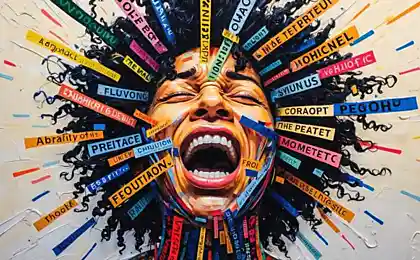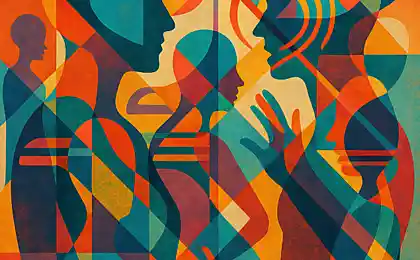360
A guide to psychology. Issue 3. Words and gestures: the foundations of effective communication
List of all articles in the cycle

Introduction
Communication is one of the most important components of human existence. We talk all the time.
At work, in the family, with friends and even with strangers. Through words, intonation, gestures and facial expressions, we express our thoughts.
We have fears and desires, and what others want us to know. In today's world, skill communication
It became even more important: globalization, working in different cultural environments and the rapid dissemination of information.
They take our communication skills to a new level.
In this article, we will look at how human interaction works, why it goes beyond simple word transfer.
And how gestures and nonverbal cues make as much sense as speech.
Popular science will allow you to better understand the phenomenon of communication.
But it's still accessible to people who are just beginning to study psychology and social processes.
Main part
The meaning of words and language as an instrument of interaction
Human speech is a complex system consisting of vocabulary, grammar and syntax. But words are not just a set of sounds.
a carriers of meanings, cultural codes and emotional subtext. The same word in different contexts.
Or with a different intonation can take on a completely different meaning: imagine how “thank you” might sound.
with a joyful, sarcastic or desperate shade.
Linguists and psycholinguists (for example, Noam Chomsky and Lev Vygotsky) argue that language shapes our very thinking.
It doesn't just reflect it. Key pointCommunication success is often determined by
How well our interlocutor correctly "reads" the subtext that we put into speech.
If a person takes our words literally, ignoring their emotional message, there may be misunderstandings.
and even conflict. More information about this is available on Wikipedia.
Nonverbal Signals: Body Language and Gesture
Most people intuitively perceive gestures, postures and facial expressions as part of full communication.
But they don't always realize how big the "share" of nonverbal signals is in the total amount of information transmitted.
According to a number of studies (including the famous, albeit controversial, works of Albert Mehrabyan),
nonverbal communication It can significantly affect the impression we make.
For example, raised eyebrows and a slight smile indicate friendliness.
While tense lips and frowning forehead can signal aggression or distrust.
Hand gestures, eye contact, tilt of the body - all these details add up to a holistic picture.
Often we "read" it on a subconscious level and draw conclusions about the intentions and mood of the interlocutor.
Not even knowing how they came to a particular opinion.

How words and gestures work together
Nonverbal signals reinforce, complement, or sometimes even contradict what we say out loud.
If you say, "I'm very happy to see you," but you avoid eye contact and stand with your arms crossed on your chest,
The other person will feel the inconsistency between your words and gestures.
A person tends to trust nonverbal signs more because they seem less controlled.
Therefore congruence Consistency of speech and nonverbal manifestations is one of the criteria of persuasiveness in communication.
When speech and gesture support each other, our message is perceived more confidently and sincerely.
For example, if a person talks about his joy at the success of a project, and his face expresses delight.
The hands are "open" and actively gesture, it looks as plausible as possible.
But if the nonverbal signal goes against the words, the listener has a feeling of ambiguity or even deception.
Active listening: the key to effective dialogue
Communication is not only “talking” but also a skill. listen. Active hearing suggests,
We're not just silently waiting for someone else's speech to end, but we're also participating in the process of nodding, clarifying the details.
We ask and clarify the key points. It lets you know that you are really involved and
You're trying to figure it out.
Simple methods of active listening:
- Paraphrasing. Repeat in your own words what the interlocutor said to make sure that you understand correctly.
- Clarifying questions. Ask: “Do I understand correctly what you wanted to say...?” or “Can you tell me more about it?”
- Verbal reinforcement. Use short lines like “yes, I understand” or “exactly” to show that you are following the conversation.
- Reflection of emotions. Sometimes it’s helpful to clarify how someone feels: “Does that seem to upset you?”
Not just an interlocutor, but an ally in the search for common language and meaning.
Difficulties and barriers to communication
Stereotypes and prejudices
We tend to judge people through our own beliefs and experiences. Such settings may interfere with hearing,
What the interlocutor is actually saying, and assign to him thoughts that he does not have.
Strong stereotypes – cultural, national or gender – often lead to conflict and misunderstanding.
It is important to recognize the presence of bias in time and consciously work overcoming it.
Emotional barriers
Too much stress, resentment, or irritation can freeze our ability to communicate.
When a person is absorbed in his emotions, he hears not the words of the interlocutor, but only his own internal monologues and expectations.
In such situations, it is important to either take a pause to calm down or explain to a communication partner.
You are not emotionally ready to continue the conversation in a constructive way.
Cultural differences
In a globalized world, many people face different cultures. The differences can relate to everything:
From words and manners of speech to gestures and personal space. Well, in some cultures.
A firm handshake is considered a sign of confidence, and in others it can be perceived as aggressive.
Before you draw conclusions about the “strange” behavior of a foreign colleague or tourist, it is worth considering that he or she may have a problem.
completely different standards of etiquette and nonverbal communication.

Conclusion
Words and gestures are the two halves of a common communication system. It’s not enough to just know the right words.
Or to formulate thoughts correctly if we do not notice what we are saying. body and how to "read" the interlocutor's signals.
On the contrary, the skillful combination of spoken language and non-verbal signs gives our messages credibility.
It creates a sense of authenticity and helps build deeper connections with people.
In this article, we discussed the basic principles of effective interaction: congruence of words and gestures, active listening.
Understanding the cultural context and the ability to overcome barriers to communication. Of course, we just opened the door.
The vast world of communication skills. But that may be enough to re-examine habitual patterns of behavior.
Identify your mistakes and take the next step. “communicative intelligence”.
In our next series, we will continue to talk about human nature, emotional perception.
Self-realization and social connections. The communication skills that we've talked about today will form the basis for understanding those complex processes.
which we will discuss in the next editions. As we have learned, the word without gesture is only part of the story.
A gesture without words remains a mystery to the interlocutor. The most interesting thing begins when they work together.
Glossary
Nonverbal communication
The set of signals transmitted through facial expressions, gestures, posture, look and distance in space.
Congruence
Consistency between words and nonverbal expressions, in which external speech coincides with internal emotions.
Active hearing
The skill of dialogue, in which the listener shows interest, asks clarifying questions and tries to correctly understand the speaker.
Stereotypes
Simplified and often incorrect representations of groups of people, forming biased attitudes and judgments.
Albert Mehrabian
A psychologist known for research on nonverbal communication and the effects of body signals on communication.
A guide to psychology. Issue 2. The Power of Emotions: How to Recognize and Understand Your Feelings
A guide to psychology. Issue 4. Society and Culture: The Unwritten Rules of the Human World























